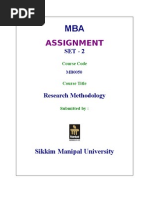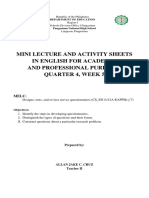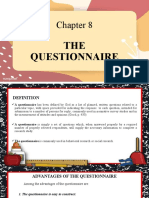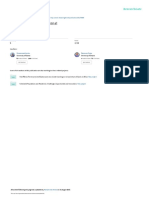Lesson 2.2 PDF
Uploaded by
Kaila SalemLesson 2.2 PDF
Uploaded by
Kaila Salem2.
2 SURVEY RESEARCH
Survey research is one of the most important areas of measurement in applied
social research. The broad area of survey research encompasses any measurement
procedures that involve asking questions of respondents. A "survey" can be anything
forms a short paper-and-pencil feedback form to an intensive one-on-one in-depth
interview.
We'll begin by looking at the different types of surveys that are possible. These
are roughly divided into two broad areas: Questionnaires and Interviews. Next, we'll
look at how you select the survey method that is best for your situation. Once you've
selected the survey method, you have to construct the survey itself.
Types of Surveys
Surveys can be divided into two broad categories: the questionnaire and
the interview.
Questionnaires are usually paper-and-pencil instruments that the respondent
completes. Interviews are completed by the interviewer based on the respondent
says. Sometimes, it's hard to tell the difference between a questionnaire and an
interview. For instance, some people think that questionnaires always ask short closed-
ended questions while interviews always ask broad open-ended ones. But you will see
questionnaires with open-ended questions (although they do tend to be shorter than in
interviews) and there will often be a series of closed-ended questions asked in an
interview.
Survey research has changed dramatically. Computers, mobile phones, internets
are available for a fast, and easy online survey. A whole new variation of group
interview has also evolved as focus group methodology.
Questionnaires
When most people think of questionnaires, they think of the mail
survey.
There are many advantages in using questionnaire.
It can be send to a wide number of people. They allow the respondent to fill it out at
their own convenience.
But there are some disadvantages as well. Response rates from questionnaires are
often very low. And, mail questionnaires are not the best vehicles for asking for detailed
written responses.
A second type is the group administered questionnaire. A sample of respondents is
brought together and asked to respond to a structured sequence of questions.
1|Lesson 2.2 Lynn Remo2020
Traditionally, questionnaires were administered in group settings for
convenience. The researcher could give the questionnaire to those who were present
and be fairly sure that there would be a high response rate. If the respondents were
unclear about the meaning of a question they could ask for clarification. And, there
were often organizational settings where it was relatively easy to assemble the group
(in a company or business, for instance).
What's the difference between a group administered questionnaire and a
group interview or focus group?
In the group administered questionnaire, each respondent is handed an
instrument and asked to complete it while in the room. Each respondent completes an
instrument. While, in the group interview or focus group, the interviewer facilitates the
session. People work as a group, listening to each other's comments and answering the
questions. Someone takes notes for the entire group -- people don't complete an
interview individually.
A less familiar type of questionnaire is the household drop-
off survey. In this approach, a researcher goes to the
respondent's home or business and hands the respondent the
instrument.
In some cases, the respondent is asked to mail it back or the
interview returns to pick it up. This approach attempts to blend
the advantages of the mail survey and the group administered questionnaire. Like the
mail survey, the respondent can work on the instrument in private, when it's
convenient. Like the group administered questionnaire, the interviewer makes personal
contact with the respondent -- they don't just send an impersonal survey instrument.
And, the respondent can ask questions about the study and get clarification on what is
to be done. Generally, this would be expected to increase the percent of people who are
willing to respond.
Interview
Interviews are a far more personal form of research than
questionnaires. In the personal interview, the interviewer works
directly with the respondent. Unlike with questionnaire, the
interviewer has the opportunity to probe or ask follow-up questions.
And, interviews are generally easier for the respondent, especially if
what is sought is opinions or impressions. Interviews can be very
2|Lesson 2.2 Lynn Remo2020
time consuming and they are resource intensive. The interviewer is considered a part of
the measurement instrument and interviewers have to be well trained in how to
respond to any contingency.
Almost everyone is familiar with the telephone interview.
Telephone interviews enable a researcher to gather information
rapidly. Most of the major public opinion polls that are reported
were based on telephone interviews. Like personal interviews,
they allow for some personal contact between the interviewer
and the respondent. And, they allow the interviewer to ask
follow-up questions.
But they also have some major disadvantages. Many people don't have publicly-
listed telephone numbers. Some don't have telephones or mobile phones. People often
don't like the intrusion of a call to their homes. And, telephone interviews have to be
relatively short or people will feel imposed upon.
Constructing the Survey
There are numerous small decisions that must be made in constructing a survey,
such as the content, wording, format, and placement. It has important consequences
for your entire study.
There are three areas involved in writing a questionnaire:
determine the question content, scope and purpose
choosing the response format that you use for collecting information from the
respondent
figuring out how to word the question to get at the issue of interest
Finally, once you have your questions written, there is the issue of how best to
place them in your survey.
Although there are many aspects of survey construction that are just common
sense, if one is not careful you can make critical errors that have dramatic effects on
the results.
Types Of Questions
Survey questions can be divided into two broad
types: structured and unstructured.
3|Lesson 2.2 Lynn Remo2020
Dichotomous Questions
When a question has two possible responses, we consider it dichotomous.
Surveys often use dichotomous questions that ask for a Yes/No, True/False or
Agree/Disagree response. There are a variety of ways to lay these questions out on a
questionnaire:
Do you believe in same sex marriage?
_______yes _____No
Gender
_______Male ______Female
Questions Based on Level Of Measurement
Questions can be classified in terms of their level of measurement. For instance, we
might measure occupation using a nominal question. In the example below,
the number next to each response has no meaning except as a placeholder for
that response. The choice of a "2" for a businessman and a "1" for a public
servant is arbitrary. From the numbering system used we can't infer that a
businessman is "twice" something that a public servant is.
Occupation class
1 – Public servant
2 – Businessman
3 - Others
A nominal question is a type of survey question that presents people with multiple
answer choices; the answers are non-numerical in nature and don't overlap
(unless you include an ‘all of the above’ option).
When to use nominal questions?
Nominal questions work well when there is a limited number of categories for a
given question. They’re easy for people to answer and for you to create graphs, but
the disadvantage is that it may have a lot of categories for respondents to choose from.
4|Lesson 2.2 Lynn Remo2020
Which browser are you using?
1. Chrome
2. Safari
3. Firefox
4. Explorer
5. Other (allows open-ended response)
We might ask respondents to rank order their preferences for favorite subjects using
an ordinal question
Rank the subjects in order of preference from best to worst
_____Filipino
_____English
_____Mathematics
_____Social Science
_____Physics
The respondent can put a 1, 2, 3, 4 or 5 next to the subject, where 1 is the
respondent's first choice. State explicitly the instruction so as not to confuse the
respondent.
We can also construct survey questions that attempt to measure on an interval level.
One of the most common of these types is the traditional 1-to-5 rating (or 1-to-
7, or 1-to-9, etc.). This is sometimes referred to as a Likert response scale.
The Likert scale is typically a 5- or 7- point scale that evaluates a respondent’s
level of agreement with a statement or the intensity of their reaction towards
something.
The scale develops symmetrically: the median number (e.g., a ‘3’ on a 5-point
scale) indicates a point of neutrality, the lowest number (always a ‘1’) indicates an
extreme view, and the highest number (e.g., a ’5’ on a 5-point scale) indicates the
opposite extreme view.
5|Lesson 2.2 Lynn Remo2020
1 2 3 4 5
Strongly Disagree Neutral Agree Strongly
Disagree Agree
Covid-19 has also advantages
Another interval question uses an approach called the semantic differential.
Here, an object is assessed by the respondent on a set of bipolar adjective pairs (using
5-point rating scale):
Please state your opinions on the subject, Statistics
Finally, we can also get at interval measures by using what is called a cumulative
or Guttman scale. Here, the respondent checks each item with which they agree. The
items themselves are constructed so that they are cumulative which means that if you
agree to one, you probably agree to all of the ones in the list
6|Lesson 2.2 Lynn Remo2020
Filter or Contingency Questions
Sometimes you have to ask the respondent one question in order to determine if
they are qualified or experienced enough to answer a subsequent one. This requires
using a filter or contingency question. For instance, you may want to ask one question
if the respondent has ever smoked marijuana and a different question if they have not.
in this case, you would have to construct a filter question to determine whether they've
ever smoked marijuana:
Response Format
The response format is how you collect the answer from the respondent. It is
classified into unstructured response formats and structured response formats.
Structured Response Formats
Structured formats help the respondent to respond more easily and help the
researcher to accumulate and summarize responses more efficiently. Below are
examples of structured formats
Fill-In-The-Blank. One of the simplest response formats is a blank line. A blank
line can be used for a number of different response types. For instance:
7|Lesson 2.2 Lynn Remo2020
Gender:
_____ Male
_____ Female
_____ LGBT+
The respondent can put a check mark or an X next to the response. This is also
an example of a dichotomous response, because it only has two possible values. Other
common dichotomous responses are True/False and Yes/No. Here's another common
use of a fill-in-the-blank response format:
Please enter your preference for the following candidates where '1' = your first choice,
'2' = your second choice, and so on.
_____ Robert Dole
_____ Colin Powell
_____ Bill Clinton
_____ Al Gore
Check The Answer. The respondent places a check next to the response(s).
The simplest form would be the example given above where the person is asks
to indicate their gender. Sometimes, a box is used so that the respondent can fill
in with an 'X'.
Please check the box if the following gadget is/are available in your home.
Computer
Laptop
Mobile phone
Printer
In the example, it is possible to check more than one response. This is
sometimes referred to as a multi-option variable. Ina multi-option variable the
respondent can select any of the options, thus, each option is treated as a separate
variable.
For instance, for each option we would normally enter either a '0' if the
respondent did not check it or a '1' if the respondent did check it. For the example
8|Lesson 2.2 Lynn Remo2020
above, if the respondent had only a mobile phone, we would enter the sequence 0, 0,
1, 0. The reason for this code is to easily compute the sum and percentage especially if
we are using spreadsheet in summarizing the data.
Circle The Answer. Sometimes the respondent is asked to circle an item to
indicate their response. For instance, we might have the following:
Notice that you can only check one option at a time. The rule of thumb is that
you ask someone to circle an item. In contrast to the multi-option variable described
above, we refer to this type of item as a single-option variable. Even though the
respondent has multiple choices, they can only select one of them. This would be
analyzed as a single variable that can take the integer values from 1 to 5.
Unstructured Response Formats
While there are a wide variety of structured response formats, there are
relatively few unstructured ones.
What is an unstructured response format? Generally, it is a written text. If the
respondent (or interviewer) writes down text as the response, you've got an
unstructured response format. These can vary from short comment boxes to the
transcript of an interview.
In almost every short questionnaire, there are one or more short text field
questions. One of the most frequent goes something like this:
Please add any other comments:
_____________________
9|Lesson 2.2 Lynn Remo2020
OUTPUT 3
Let’s DO this
Group activity
Look for two (2) sample questionnaires (if possible, in line with your
course). In each questionnaire, identify the type of questions
(Dichotomous, based on level of measurement, etc.). Also, identify its
possible response format
Take a picture or a screen shot of the questionnaires.
You can either write or encode your answers.
Email the output at lynnremo@buksu.edu.ph
File name and subject in email: Section code A2.2 – Last names
10 | L e s s o n 2 . 2 Lynn Remo2020
You might also like
- Hourglass Workout Program by Luisagiuliet 276% (21)Hourglass Workout Program by Luisagiuliet 251 pages
- The Hold Me Tight Workbook - Dr. Sue Johnson100% (16)The Hold Me Tight Workbook - Dr. Sue Johnson187 pages
- Read People Like A Book by Patrick King-Edited62% (66)Read People Like A Book by Patrick King-Edited12 pages
- Livingood, Blake - Livingood Daily Your 21-Day Guide To Experience Real Health77% (13)Livingood, Blake - Livingood Daily Your 21-Day Guide To Experience Real Health260 pages
- COSMIC CONSCIOUSNESS OF HUMANITY - PROBLEMS OF NEW COSMOGONY (V.P.Kaznacheev,. Л. V. Trofimov.)94% (212)COSMIC CONSCIOUSNESS OF HUMANITY - PROBLEMS OF NEW COSMOGONY (V.P.Kaznacheev,. Л. V. Trofimov.)212 pages
- Donald Trump & Jeffrey Epstein Rape Lawsuit and Affidavits83% (1016)Donald Trump & Jeffrey Epstein Rape Lawsuit and Affidavits13 pages
- The 36 Questions That Lead To Love - The New York Times94% (34)The 36 Questions That Lead To Love - The New York Times3 pages
- The 36 Questions That Lead To Love - The New York Times95% (21)The 36 Questions That Lead To Love - The New York Times3 pages
- Jeffrey Epstein39s Little Black Book Unredacted PDF75% (12)Jeffrey Epstein39s Little Black Book Unredacted PDF95 pages
- The 4 Hour Workweek, Expanded and Updated by Timothy Ferriss - Excerpt23% (954)The 4 Hour Workweek, Expanded and Updated by Timothy Ferriss - Excerpt38 pages
- Advantages and Disadvantages of The Survey Method100% (2)Advantages and Disadvantages of The Survey Method5 pages
- Questionnaire Design and Construction QuestionnairesNo ratings yetQuestionnaire Design and Construction Questionnaires4 pages
- In This Type of Interview, The Respondents Answer The Questions Based On What TheyNo ratings yetIn This Type of Interview, The Respondents Answer The Questions Based On What They6 pages
- Business Outlook: Open-Versus Close-Ended Survey QuestionsNo ratings yetBusiness Outlook: Open-Versus Close-Ended Survey Questions5 pages
- Research Instrument, Validation and Test of Reliability100% (1)Research Instrument, Validation and Test of Reliability13 pages
- Marketing Research: CH-7 Questionnaire DesignNo ratings yetMarketing Research: CH-7 Questionnaire Design59 pages
- Finding Answers Through Data CollectionNo ratings yetFinding Answers Through Data Collection29 pages
- Research Methods: Designing and Writing Effective SurveysNo ratings yetResearch Methods: Designing and Writing Effective Surveys44 pages
- Mini Lecture and Activity Sheets in English For Academic and Professional Purposes Quarter 4, Week 5No ratings yetMini Lecture and Activity Sheets in English For Academic and Professional Purposes Quarter 4, Week 511 pages
- SP Cont 4 Data Collection and Samplin TechniquesNo ratings yetSP Cont 4 Data Collection and Samplin Techniques92 pages
- Basic Tools of Data Collection - Interview Method, Interview ScheduleNo ratings yetBasic Tools of Data Collection - Interview Method, Interview Schedule4 pages
- Describe Depth Interview Technique and Explain Projective TechniquesNo ratings yetDescribe Depth Interview Technique and Explain Projective Techniques11 pages
- Designing A Questionnaire: Submitted by Priyanka AgarwalNo ratings yetDesigning A Questionnaire: Submitted by Priyanka Agarwal34 pages
- Qualitative Research Data Collection Techniques. (Final Starts From Here)No ratings yetQualitative Research Data Collection Techniques. (Final Starts From Here)3 pages
- English For Academic and Professional Purposes0% (1)English For Academic and Professional Purposes14 pages
- Methods and Techniques of Data Collection in Research100% (2)Methods and Techniques of Data Collection in Research35 pages
- Chapter 4 - Survey Research: Characteristics of The Communication ApproachNo ratings yetChapter 4 - Survey Research: Characteristics of The Communication Approach6 pages
- Accounting Research Journal September 2015No ratings yetAccounting Research Journal September 201525 pages
- Pointers in Business Law Suarez 1pdf PDFNo ratings yetPointers in Business Law Suarez 1pdf PDF204 pages
- The Katipunan and The First Cry of The Revolution by SamsonNo ratings yetThe Katipunan and The First Cry of The Revolution by Samson19 pages
- Negotiable Instruments Law: Sections 181 To 186No ratings yetNegotiable Instruments Law: Sections 181 To 18623 pages
- Stock Market Efficiency & Stock ValuationNo ratings yetStock Market Efficiency & Stock Valuation23 pages
- Solid waste sampling is a critical process to analyze and manage waste effectivelyNo ratings yetSolid waste sampling is a critical process to analyze and manage waste effectively2 pages
- Medical Center Map - Directions - Hotel Information PDFNo ratings yetMedical Center Map - Directions - Hotel Information PDF3 pages
- Module 2 - Handout 2.0 - Demand Theory, Analysis and EstimationNo ratings yetModule 2 - Handout 2.0 - Demand Theory, Analysis and Estimation4 pages
- Ash Handling System: in A 210 M.W Boiler, The Coal Consumption Is 3,500 M.T S Per Day The Ash Content Is 1,400 M.T SNo ratings yetAsh Handling System: in A 210 M.W Boiler, The Coal Consumption Is 3,500 M.T S Per Day The Ash Content Is 1,400 M.T S22 pages
- Adi Shankara Got Into An Argument With A Man and WonNo ratings yetAdi Shankara Got Into An Argument With A Man and Won2 pages
- Line Tracking Robot AUTO-CAD 3D Design Project Exhibition: COMSATS Engineering Robotics CompetitionNo ratings yetLine Tracking Robot AUTO-CAD 3D Design Project Exhibition: COMSATS Engineering Robotics Competition2 pages
- TFN Transes - HX of NRG To NRG TheoristNo ratings yetTFN Transes - HX of NRG To NRG Theorist14 pages
- Contemporary Philippine Arts IntroductionNo ratings yetContemporary Philippine Arts Introduction16 pages
- Livingood, Blake - Livingood Daily Your 21-Day Guide To Experience Real HealthLivingood, Blake - Livingood Daily Your 21-Day Guide To Experience Real Health
- COSMIC CONSCIOUSNESS OF HUMANITY - PROBLEMS OF NEW COSMOGONY (V.P.Kaznacheev,. Л. V. Trofimov.)COSMIC CONSCIOUSNESS OF HUMANITY - PROBLEMS OF NEW COSMOGONY (V.P.Kaznacheev,. Л. V. Trofimov.)
- Donald Trump & Jeffrey Epstein Rape Lawsuit and AffidavitsDonald Trump & Jeffrey Epstein Rape Lawsuit and Affidavits
- The 36 Questions That Lead To Love - The New York TimesThe 36 Questions That Lead To Love - The New York Times
- The 36 Questions That Lead To Love - The New York TimesThe 36 Questions That Lead To Love - The New York Times
- Jeffrey Epstein39s Little Black Book Unredacted PDFJeffrey Epstein39s Little Black Book Unredacted PDF
- The 4 Hour Workweek, Expanded and Updated by Timothy Ferriss - ExcerptThe 4 Hour Workweek, Expanded and Updated by Timothy Ferriss - Excerpt
- Questionnaire Design and Construction QuestionnairesQuestionnaire Design and Construction Questionnaires
- In This Type of Interview, The Respondents Answer The Questions Based On What TheyIn This Type of Interview, The Respondents Answer The Questions Based On What They
- Business Outlook: Open-Versus Close-Ended Survey QuestionsBusiness Outlook: Open-Versus Close-Ended Survey Questions
- Research Instrument, Validation and Test of ReliabilityResearch Instrument, Validation and Test of Reliability
- Research Methods: Designing and Writing Effective SurveysResearch Methods: Designing and Writing Effective Surveys
- Mini Lecture and Activity Sheets in English For Academic and Professional Purposes Quarter 4, Week 5Mini Lecture and Activity Sheets in English For Academic and Professional Purposes Quarter 4, Week 5
- Basic Tools of Data Collection - Interview Method, Interview ScheduleBasic Tools of Data Collection - Interview Method, Interview Schedule
- Describe Depth Interview Technique and Explain Projective TechniquesDescribe Depth Interview Technique and Explain Projective Techniques
- Designing A Questionnaire: Submitted by Priyanka AgarwalDesigning A Questionnaire: Submitted by Priyanka Agarwal
- Qualitative Research Data Collection Techniques. (Final Starts From Here)Qualitative Research Data Collection Techniques. (Final Starts From Here)
- Methods and Techniques of Data Collection in ResearchMethods and Techniques of Data Collection in Research
- Chapter 4 - Survey Research: Characteristics of The Communication ApproachChapter 4 - Survey Research: Characteristics of The Communication Approach
- The Katipunan and The First Cry of The Revolution by SamsonThe Katipunan and The First Cry of The Revolution by Samson
- Solid waste sampling is a critical process to analyze and manage waste effectivelySolid waste sampling is a critical process to analyze and manage waste effectively
- Medical Center Map - Directions - Hotel Information PDFMedical Center Map - Directions - Hotel Information PDF
- Module 2 - Handout 2.0 - Demand Theory, Analysis and EstimationModule 2 - Handout 2.0 - Demand Theory, Analysis and Estimation
- Ash Handling System: in A 210 M.W Boiler, The Coal Consumption Is 3,500 M.T S Per Day The Ash Content Is 1,400 M.T SAsh Handling System: in A 210 M.W Boiler, The Coal Consumption Is 3,500 M.T S Per Day The Ash Content Is 1,400 M.T S
- Adi Shankara Got Into An Argument With A Man and WonAdi Shankara Got Into An Argument With A Man and Won
- Line Tracking Robot AUTO-CAD 3D Design Project Exhibition: COMSATS Engineering Robotics CompetitionLine Tracking Robot AUTO-CAD 3D Design Project Exhibition: COMSATS Engineering Robotics Competition























































































































